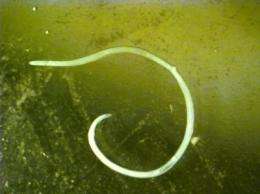A new molecular technique detects Anisakis in all fish

A new method enables anisakids to be detected in any fish product, from a whole fish, fresh or frozen, to tinned fish and surimi. Developed by Spanish scientists, the system is based on molecular techniques and overcomes the limitations of traditional procedures.
"This method is characterised by its high specificity for the Anisakis, Pseudoterranova, Contracaecum and Hysterothylacium genera and for its very high sensitivity, since the parasite can be detected even if it is present in very low quantities (0.05 pg) in the product analysed", Montserrat Espiñeira, co-author of the study explains to SINC.
The researchers, members of the Area of Molecular Biology and Biotechnology of the National Association of Manufacturers of Canned Fish and Shellfish (ANFACO-CECOPESCA), a non-profit company, developed this method using molecular techniques. The conclusions appear in the latest edition of the magazine Food Control.
"It is a quick and effective method, and unlike the procedures previously used, it can be applied to any fish product regardless of the degree to which it has been transformed", Espiñeira explains.
The methods used up to now to detect anisakid larvae were visual examination, transillumination and digestion by artificial gastric juice. These traditional systems cannot be applied to very big species, or to processed products.
Main species and hosts
Anisakids belong to the Anisakidae family and the most important genera in terms of health are Anisakis, Pseudoterranove, Contracaecum and Hysterothylacium. The species causing most parasitic infections in humans are Anisakis simplex, Pseudoterranova decipiens and, to a lesser degree, Contracaecum osculatum and Hysterothylacium aduncum.
The presence of anisakid larvae, which live as parasites in muscular tissues and the viscera, has been traced in many species of fish and cephalopods. The affected fish are cod, hake, horse mackerel, sardines, anchovies, salmon, herring, tuna, whiting, turbot, halibut and pollack), while the affected cephalopods are squid and cuttlefish.
The levels of prevalence of anisakids and the degrees of parasitization vary greatly and depend on factors such as the host species, the geographic area, the time of year and the particular features of each specimen. Humans are only an accidental host which interrupts the parasitic cycle.
Illnesses caused
Anisakidosis is a gastrointestinal infection affecting people who have consumed infected fish that is raw, not sufficiently cooked, or that has been subjected to treatments that do not guarantee that the larvae will be destroyed (marinated, in vinegar, salted, cold smoked, dried...)
This culinary trend has extended in recent years to other countries, of which Spain is one, and it is one of the reasons for the increase in illnesses caused by anisakids.
The clinical symptoms are abdominal pain, nausea, vomiting and diarrhoea. The larvae can also cause allergic reactions ranging from hives to anaphylactic reactions in more serious cases.
More information: Espiñeira M., Herrero, B., Vieites J.M., Santaclara F.J. "Detection and identification of anisakids in seafood by fragment length polymorphism analysis and PCR-RFLP of ITS-1 region". Food Control 21 (2010) 1051, julio de 2010. DOI: 10.1016/j.foodcont.2009.12.026
Provided by FECYT - Spanish Foundation for Science and Technology















